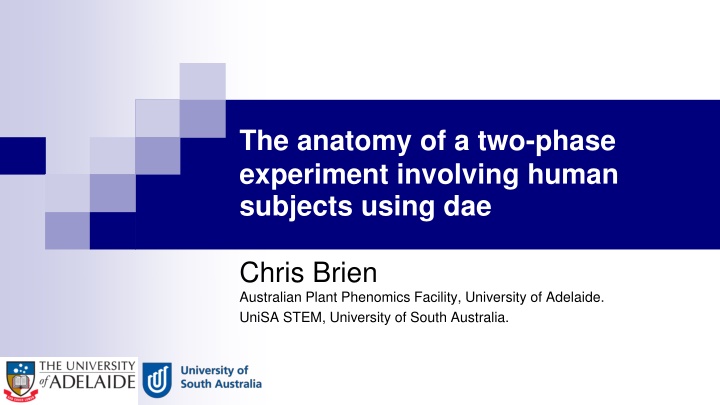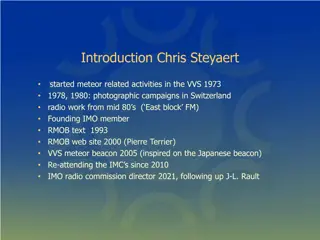
Anatomy of a Two-Phase Experiment Involving Human Subjects
Explore the anatomy of a two-phase experiment involving human subjects in pain-rating research, discussing self-assessment phases, linear mixed models, and homogeneous allocation models to understand the interrelated information. Dive into the complexities of factor allocations, motion assessments, and patient expressiveness.
Download Presentation

Please find below an Image/Link to download the presentation.
The content on the website is provided AS IS for your information and personal use only. It may not be sold, licensed, or shared on other websites without obtaining consent from the author. If you encounter any issues during the download, it is possible that the publisher has removed the file from their server.
You are allowed to download the files provided on this website for personal or commercial use, subject to the condition that they are used lawfully. All files are the property of their respective owners.
The content on the website is provided AS IS for your information and personal use only. It may not be sold, licensed, or shared on other websites without obtaining consent from the author.
E N D
Presentation Transcript
The anatomy of a two-phase experiment involving human subjects using dae Chris Brien Australian Plant Phenomics Facility, University of Adelaide. UniSA STEM, University of South Australia.
Outline 1. The self-assessment phase of a pain-rating experiment (Brien et al., 2022 SMMR). 2. The two-phase pain-rating experiment. 3. What else is in the papers. 2
1. The self-assessment phase of a pain ratingexperiment (Solomon et al., 1997; Farewell & Herzberg, 2003; Jarret et al., 2020; Brien, 2022 SMMR; Brien et al., 2023 BMJ) 8 patients, 4 judged to be expressive and 4 unexpressive. Each patient is to undergo a movement on each of 2 occasions. Two motions allocated to the occasions: active and passive motion performed without and with assistance. For clinical reasons, always active then passive. The outcomes are: i. 16 videos for 8 patients 2 Occasions; ii. A pain rating by each patient on each occasion. o 2 Expressiveness 4 Patients in E 2 Occasions A factor-allocation diagram 2 Motions 2 motions 16 videos 3
Linear mixed models from allocations for the single-phase Initial allocation model; terms derived from factors in panels, the set of factors in a panel also called a tier: o all possible combinations of factors in a panel subject to the restriction that a term with a nested factor must include its nesting factors; terms from panels that are only ever allocated are assumed fixed; the rest are assumed random; Initial fixed model Mean + M Initial random model: Mean + E + O + O:E + E:P + O:E:P. Brien et al. (2023,BMJ) discuss the interpretation of the two Mean terms. 2 Expressiveness 4 Patients in E 2 Occasions 2 Motions 2 motions 16 videos 4
Homogeneous allocation models 2 Expressiveness 4 Patients in E 2 Occasions 2 Motions 2 motions 16 videos Initial allocation model Mean + M | Mean + E + O + O:E + E:P + O:E:P. Homogeneous allocation model (a linear mixed model derived from the initial allocation model) Swap terms between fixed and random models; Include interactions involving factors from different panels (block-treatment or, more generally, intertier interactions); Fixed homogeneous allocation model (includes E and M:E interaction term): Mean + M + E + M:E. Random homogenous allocation model: Mean + O + O:E + E:P + O:E:P. No indication in the model of how the information from different terms is interrelated. For instance, which terms in the random model affect the fixed terms differences? Brien et al. (2023,BMJ) discuss fixed vs random and block-treatment interactions. 5
Anatomy to exhibit the confounding An anatomy table helps to show how the information from different terms is interrelated by exhibiting the confounding of sources of variation. o Confounding results from allocations: a source involving an allocated factor is confounded with one or more sources based on recipient factors. 6
Anatomy of the design using designAnatomy from dae (Brien, 2023 BMJ) An anatomy is based on the allocations (in a factor-allocation diagram). A formula per panel with nesting in the panel incorporated. Shorthand for terms (Wilkinson and Rogers, 1973): A/B = A + A:B ( / is called the nesting operator) A*B = A + B + A:B ( * is called the crossed operator) > ph1.canon <- designAnatomy(formulae = + list(video = ~ (Expressiveness/Patients) * Occasions, + motex = ~ Motions * Expressiveness), + data = ph1.sys) The terms for each formula are transformed into sources by designAnatomy. To do this, it works out the marginality relationships between terms. The data.frame ph1.sys contains 16 values for each of the 4 factors. 2 Expressiveness 4 Patients in E 2 Occasions 2 Motions 2 motions 16 videos Expressiveness Patients Occasions Motions 1 Exp 1 1 Act 2 Exp 1 2 Pas 3 Exp 2 1 Act 4 Exp 2 2 Pas 5 Exp 3 1 Act 6 Exp 3 2 Pas 7
Anatomy of the design Shows the confounding of motions-expressiveness with video sources? > ph1.canon <- designAnatomy(formulae = + list(video = ~ (Expressiveness/Patients) * Occasions, + motex = ~ Motions * Expressiveness), + data = ph1.sys) > summary(ph1.canon) Summary table of the decomposition for video & motex Source.video df1 Source.motex df2 aefficiency Expressiveness 1 Expressiveness 1 1.0000 Patients[Expressiveness] 6 Occasions 1 Motions 1 1.0000 Expressiveness#Occasions 1 Motions#Expressiveness 1 1.0000 Patients#Occasions[Expressiveness] 6 Motions is inextricably confounded with Occasions (no Residual); so, homogeneous model is singular. The overall verdict: To draw conclusions about Motions from this experiment requires an assumption that the differences between the first and second occasions per se are minor. All these are one and so design is orthogonal. Motions#Expressiveness is inextricably confounded with Expressiveness#Occasions 8
Compare anatomy to traditional skeleton anova videos motions-expressive Traditional anova Source df Source df Source df Expressive 1 Expressive 1 Patients[Expressive] 6 Expressive:Patients 6 Occasions 1 Motions 1 Motions 1 Expressive#Occasions 1 Expressive#Motions 1 Expressive:Motions 1 Patients#Occasions[Expressive] 6 Expressive:Patients:Motions 6 Total 15 Total 15 The anatomy displays the inextricable confounding of Motions with Occasions and of E#M with E#O. Motions are pseudoreplicated, there being only one allocation of Motions to Occasions. The two decompositions are equivalent. The ANOVA is silent about the confounding, Occasions not being included. 9
Why anatomy? Is it not just a skeleton anova table? It is very similar to Genstat s skeleton anova. It is, but An anova is used to analyse data. So, a skeleton anova is showing you how the analysis of some data will look. Most anovas do not show the confounding. These days, I generally don t do anovas I do mixed model analyses. An anatomy is the analysis of a design, rather than of data. Anatomies are based on the allocations for a design An eigenanalysis of projection matrices derived from design matrices is done. Their use is independent of the method to be used in analyzing the data. So, to emphasize this distinction I refer to the anatomy of a design. 10
2. The two-phase pain rating experiment (Solomon et al., 1997; Farewell & Herzberg, 2003; Jarret et al., 2020; Brien, 2022 SMMR) 2. Evaluation phase: 74 Raters (occupational and physical therapy students) rate pain using the videos from the first phase. Half of the raters were randomly chosen to be trained in identifying pain from facial movements, and the other half were untrained. Each rater rated the 16 videos, in the same order, at 16 viewings. The outcome of this phase is the set of 16 differences between patient and rater scores for each rater. 2 trainings A feature here is that there is an allocation of factors of interest in both phases. Previously, O and V omitted. 2 trainings 2 Trainings 2 Trainings 74 Raters 2 Expressiveness 4 Patients in E 2 Motions 74 Raters 2 Expressiveness 4 Patients in E 2 Occasions 16 Viewings 2 Motions 11 2 motions 1184 episodes 16 videos 1184 units
Linear mixed models from allocations 2 trainings 2 Trainings 74 Raters 2 Expressiveness 4 Patients in E 2 Occasions 16 Viewings 2 Motions 2 motions 1184 episodes 16 videos Initial fixed model Mean + T + M Initial random model: Mean + R + V + R:V + E + O + O:E + E:P + O:E:P. Fixed homogeneous allocation model (includes interactions between T, M & E): Mean + T + M + T:M + E + T:E + M:E + T:M:E. Random homogenous allocation model: Mean + R + V + R:V + O + O:E + E:P + O:E:P. Again, there is no indication in these models of the relationships between the terms in the models 12
Anatomy of design > ph2.canon <- designAnatomy(formulae = list(episo = ~ R * V, + video = ~ (E/P)*O, + tme = ~ T * M * E), + data = ph2.L.lay) > summary(ph2.canon, which.criteria = "aeff") 74 Raters Summary table of the decomposition for episo, video & tme 16 Viewings Source.episo df1 Source.video df2 Source.tme df3 aefficiency R 73 T 1 1.0000 Residual 72 V 15 E 1 E 1 1.0000 P[E] 6 1.0000 O 1 M 1 1.0000 E#O 1 M#E 1 1.0000 P#O[E] 6 1.0000 R#V 1095 T#M 1 1.0000 T#E 1 1.0000 T#M#E 1 1.0000 Residual 1092 1184 episodes 2 Expressiveness 4 Patients in E 2 Occasions 16 videos 2 Motions 2 motions V is exhaustively confounded by sources involving O, P and E Cannot separate viewing order from patient variability and the model will be singular; V or P#O[E] need removing, along with O and E#O. 2 Trainings 2 trainings Include interactions for factors of interest, T, M & E. 13
Including all random intertier interactions 2 trainings Jarrett, Farewell & Herzberg (2020) demonstrated the need to include random block-treatment interactions. 2 Trainings 74 Raters 2 Expressiveness 4 Patients in E 2 Occasions 16 Viewings 2 Motions 2 motions 1184 episodes 16 videos The intertier interactions are all terms involving factors from different panels, except not between a factor and the factor(s) to which it is allocated; cannot be estimated due to a lack of replication. o e.g. Trainings and Raters, for which there is only one training for each rater. Random model with inter-tier interactions: Same as the block-treatment interactions of J, F & H. E:P + R + V + R:V + (T * M):P:E + T:V + R:M + R:O * (E / P)). Are all terms estimable? How is the analysis affected? How is the information distributed? > ph2.homogint.canon <- designAnatomy(formulae = list(episo = ~ R * V, + train = ~ T * V, + video = ~ R * O * (E/P), + motion = ~ T * M * (E/P) + M * R), + data = ph2.L.lay) 14
Anatomy of the design Source.episo df1 Source.train df2 Source.video df3 Source.motion df4 aefficiency R 73 T 1 R 1 T 1 1.0000 Residual 72 R 72 R[T] 72 1.0000 V 15 V 15 O 1 M 1 1.0000 E 1 E 1 1.0000 P[E] 6 P[E] 6 1.0000 O#E 1 M#E 1 1.0000 O#P[E] 6 M#P[E] 6 1.0000 R#V 1095 T#V 15 R#O 1 T#M 1 1.0000 R#E 1 T#E 1 1.0000 R#P[E] 6 T#P[E] 6 1.0000 R#O#E 1 T#M#E 1 1.0000 R#O#P[E] 6 T#M#P[E] 6 1.0000 Residual 1080 R#O 72 M#R[T] 72 1.0000 R#E 72 1.0000 R#P[E] 432 1.0000 R#O#E 72 1.0000 R#O#P[E] 432 1.0000 intertier interactions, with some sources inextricably confounded (e.g. T#M). Complicated confounding of An orthogonal design, even with intertier interactions. 15
6. What else is in the papers Brien (2022 SMMR) gives: An analysis using asreml and asremlPlus of the published data that includes both intertier interactions and heterogeneous variances. A proposed design with more power than the original, given the results of the analysis. Brien, Sermarini & Dem trio (2023 BMJ) : Gives a tutorial on the factor-allocation paradigm for standard experiments It uses many examples, explains the terminology, has R scripts for producing the anatomies and includes EMSqs in the anatomy tables. Stresses that usually designs are chosen that are A-optimal for an anticipated linear mixed model, although this may only be done implicitly. Discusses fixed vs random, pooling nonsignificant terms and the inclusion of block-treatment interaction. Highlights differences between experiments involving a time factor. Gives a consolidated analysis of nonorthogonal designs. 1. o 2. 3. 4. 5. 16
References Brien, C. J. (2022). Designing, understanding and modelling two-phase experiments with human subjects. Statistical Methods in Medical Research, 31(4), 626-645. Brien (2023) dae: functions useful in the design and ANOVA of experiments. Version 3.215. http://cran.r-project.org/package=dae/. Brien, C. J., Sermarini, R. A., & Demetrio, C. G. B. (2023). Exposing the confounding in experimental designs to understand and evaluate them, and formulating linear mixed models for analyzing the data from a designed experiment. Biometrical Journal, https://doi.org/10.1002/bimj.202200284. Butler, D. G., Cullis, B. R., Gilmour, A. R., Gogel, B. J., & Thompson, R. (2020). ASReml-R reference manual. Version 4.1.0.130. Retrieved from http://asreml.org Farewell, V. T., & Herzberg, A. M. (2003). Plaid designs for the evaluation of training for medical practitioners. Journal of Applied Statistics, 30(9), 957-965. Jarrett, R. G., Farewell, V. T., & Herzberg, A. M. (2020). Random effects models for complex designs. Statistical Methods in Medical Research, 29(12), 3695-3706. Solomon, P. E., Prkachin, K. M., & Farewell, V. (1997). Enhancing sensitivity to facial expression of pain. Pain, 71(3), 279-284. Thank you for your attention! 17 17






















